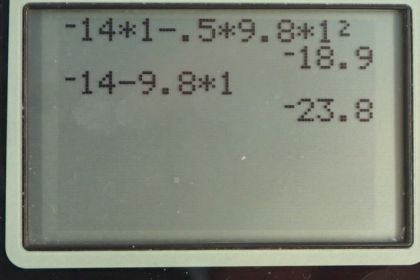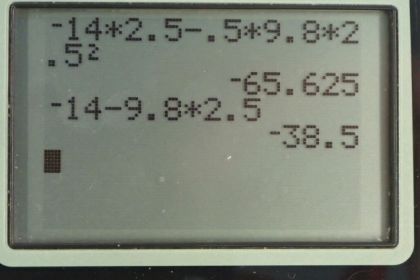- ,
- ,
- ,
- ,
- ,
Solution video
OpenStax College Physics, Chapter 2, Problem 42 (Problems & Exercises)

Calculator Screenshots
Comments
Why would one not value Y subscript 0 at 70m, since the bridge is 70m above the water? The way the question is written, I see the water as being 0. When I did the problems, I got the inverse of your answers, where y subscript 1 is equal to 61.8m, y subscript 2 is equal 51.5, y subscript 3 is equal to 38, etc.
I understand your method, but I am wondering if my answers are wrong because I placed the values differently based on my reading of the question.
I don't understand how he has gravity positive when the coordinate system is clearly positive N and E and negative S and W. Gravity is clearly down which should equate to -9.8. I think his answers are wrong.
No they aren't because if you think logically, y will always be negative after you throw something downwards when gravity is present, and that applies to velocity too
So we just don't worry about the 70m?
Hi jsotosky, thank you for the question. No, the 70m height of the bridge doesn't matter. If the displacement had been more than 70m downward, then that would complicate things since it would no longer be free falling since the drag due to water can't be ignored the way air drag is being ignored...
(a) At 0.500 s:
Displacement: 61.775 m above the water
Velocity: 18.9 m/s downward
(b) At 1.00 s:
Displacement: 51.1 m above the water
Velocity: 23.8 m/s downward
(c) At 1.50 s:
Displacement: 37.975 m above the water
Velocity: 28.7 m/s downward
(d) At 2.00 s:
Displacement: 22.4 m above the water
Velocity: 33.6 m/s downward
(e) At 2.50 s:
Displacement: 4.375 m above the water
Velocity: 38.5 m/s downward
Note that the displacement is measured from the water's surface, and the velocity is the speed at which the rock is moving downward.
Similar to a question above, and despite the answer re: negative displacement, I'm still stuck on why -9.80 m/s^2 is not used for g. The upward direction has been defined as +, so a = -g = -9.80 m/s^2.
Is this b/c the equation needed for -g, defines g as + g (this is in the textbook just above equation 2.75) and you need to switch the sign from neg. (-) to positive (+). Is this really a matter of always thinking of acceleration due to gravity as +9.80 m/s^2 and just making sure you have the correct equation for y based on the coordinate system?
Confused! Thanks for any help.
I think I finally figured this out. Please correct my thinking below if I'm wrong.
You can approach this problem 1 of 2 ways.
One way is to always consider the sign of g and to change the sign based on the given coordinate system. In this problem, g is moving is a negative y direction and so you would use -9.8 (with a neg. sign) and plug this into 𝑦=𝑦0+𝑣0𝑡 +1/2𝑔𝑡^2 and 𝑣=𝑣0+𝑔𝑡.
The second approach is to always consider g as positive +9.8 regardless of the coordinate system and instead you must apply the correct kinematic equations. In this example, because the acceleration due to gravity is downward, you have to use 𝑦=𝑦0+𝑣0𝑡−12𝑔𝑡^2 [equation 2.76] and 𝑣=𝑣0−𝑔𝑡 [equation 2.75].
In either approach, velocity is negative because the rock is moving in a negative y direction.
Hi sd, thank you for the question. is the magnitude of the acceleration due to gravity, which means it is always positive . When the coordinate system is defined in the usual way with up as positive, and a free falling object is therefore accelerating down due to gravity, then the acceleration of the object is . Some kinematics formulas have an for acceleration, in which case you would substitute , whereas other kinematics formulas are case-specific for free falling objects in an "up is positive" coordinate system, in which case the negative is taken care of in the formula, and is replaced with .
Hope this helps,
Shaun








